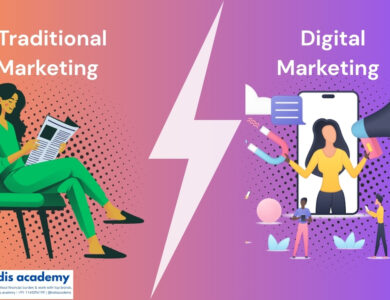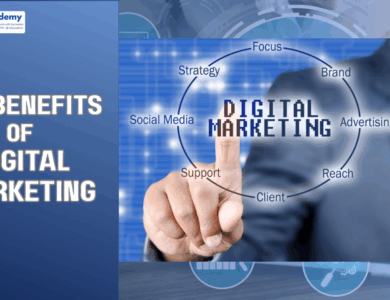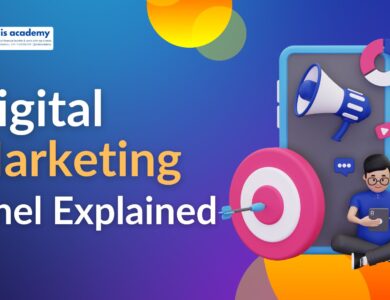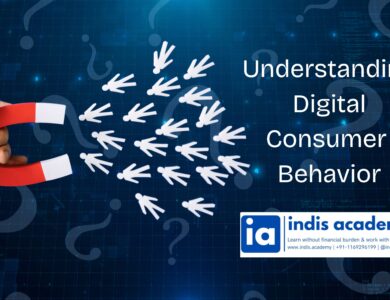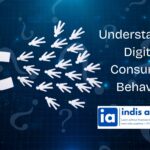Top Types of Digital Marketing – SEO, SEM, SMM, Email & More Explained
Explore the top types of digital marketing like SEO, SEM, SMM, and Email Marketing. Learn what each type means and how it can grow your business online.
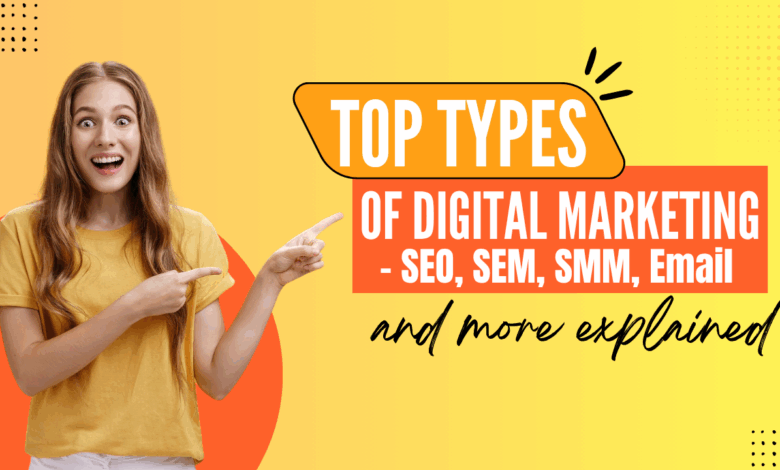
If you’ve ever felt overwhelmed by terms like SEO, SEM, SMM, or email automation, you’re not alone.
In today’s fast-paced digital world, businesses, marketers, and even freelancers are constantly bombarded with marketing jargon. The bigger question is: Which type of digital marketing actually works? Which one should you focus on?
The truth is—there’s no one-size-fits-all answer. Each type of digital marketing serves a different purpose depending on your goals, audience, and budget. Some are designed for long-term organic growth (like SEO), while others (like SEM or paid ads) deliver instant visibility.
In this guide, we’ll break down the top types of digital marketing—from search engine optimization to social media marketing, email campaigns, influencer collaborations, and more.
You’ll learn:
- What each type really means (beyond just definitions),
- When to use it and why,
- What tools and strategies professionals actually rely on.
So whether you’re a startup founder, a marketing executive, or someone building their personal brand—by the end of this article, you’ll have a crystal-clear view of which digital marketing types will fuel your success in 2025 and beyond.
Let’s dive in.
What is Digital Marketing?
At its core, digital marketing is the art and science of promoting products, services, or brands using the internet and electronic devices. If traditional marketing is the billboard by the highway, digital marketing is the notification on your phone, the Google search result, or the Instagram ad you clicked on last night.
But it’s not just about ads—it’s about creating meaningful experiences across digital touchpoints.
Digital marketing spans a wide ecosystem of channels: websites, search engines, email, mobile apps, social media platforms, and even smart speakers. It’s where your audience lives, scrolls, and shops today.
Here’s a quick breakdown of how digital marketing evolved:
- Early 2000s: Email marketing and banner ads dominated.
- 2010s: SEO, Google Ads, and Facebook transformed how brands reached consumers.
- Today: It’s all about personalization, automation, video content, and omnichannel strategies.
Whether you’re running a small business or managing a global brand, having a presence online isn’t optional anymore—it’s your digital storefront. And just like with any storefront, the more people you attract, engage, and convert—the more successful you become.
But how do you actually do that?
That’s where the different types of digital marketing come in. Each type plays a specific role in capturing attention, building trust, and driving sales.
Let’s explore them one by one—starting with the king of organic visibility: SEO.
Search Engine Optimization (SEO) – The Organic King
When people say “I found it on Google,” it’s not magic—it’s SEO at work.
Search Engine Optimization (SEO) is the process of optimizing your website and content to rank higher on search engines like Google, Bing, or Yahoo. It’s about making sure that when someone searches for something related to your business, you show up—not your competitor.
✅ How SEO Works (In Simple Terms)
SEO involves three major pillars:
- On-Page SEO – This includes optimizing content, meta tags, headings, internal linking, and keyword usage to help search engines understand what your pages are about.
- Off-Page SEO – This focuses on building authority by earning backlinks from reputable sites. Think of it as “votes of trust” that tell Google your content is valuable.
- Technical SEO – This ensures your site is crawlable, fast, secure (HTTPS), mobile-friendly, and structured correctly. Even great content won’t rank if your site is poorly coded.
🎯 Why SEO Matters
- Cost-Effective: Unlike paid ads, SEO doesn’t charge you per click. Once you rank, traffic keeps coming with little ongoing cost.
- Long-Term Results: SEO is not instant—but it builds a powerful organic presence over time.
- User Trust: Users tend to trust organic results more than ads.
- High ROI: When done right, SEO brings some of the highest returns in digital marketing.
🛠 Tools You’ll Need
- Google Search Console – For performance tracking
- Ahrefs / SEMrush – For keyword and backlink research
- Yoast SEO / Rank Math (if using WordPress) – For on-page optimization
🧠 Best Use Cases
SEO is ideal if:
- You’re building a blog or content-heavy website
- You want to drive consistent, evergreen traffic
- You’re focused on long-term brand authority
But remember—SEO is a marathon, not a sprint. If you need faster results, you might want to look at our next channel…
Search Engine Marketing (SEM) – Fast Results with Paid Search
While SEO builds your visibility organically, Search Engine Marketing (SEM) helps you reach the top of search results—instantly, using paid advertising.
Ever noticed the first few results on Google that say “Sponsored”? That’s SEM in action, typically powered by Google Ads.
🚀 What is SEM?
SEM involves running pay-per-click (PPC) ads on search engines. You bid on specific keywords, and when someone searches using those terms, your ad can appear above organic results.
You only pay when someone clicks—hence the name PPC.
SEO vs SEM – What’s the Difference?
| SEO (Organic) | SEM (Paid) |
|---|---|
| Long-term investment | Immediate visibility |
| No direct cost per click | Cost per click (CPC) |
| Builds trust slowly | Drives fast traffic |
| Slower results | Instant, scalable reach |
Both have their place in a good strategy—many successful businesses combine SEO and SEM for maximum coverage.
🎯 Why Use SEM?
- Speed: You can launch a campaign today and start getting traffic within hours.
- Targeting Power: Filter by location, time, device, and more.
- A/B Testing: Quickly test messaging and landing pages.
- Conversion Focused: Great for sales funnels, lead gen, or product launches.
📊 Tools to Know
- Google Ads – The primary platform for SEM
- Google Keyword Planner – Helps choose the right keywords
- Ubersuggest / SpyFu – Competitor keyword tracking
🧠 Best Use Cases
SEM is a smart choice if:
- You’re launching a new product/service
- You need immediate traffic or leads
- You’re in a competitive niche where SEO is too slow
But here’s the catch: SEM only works as long as you pay. The moment your budget dries up, so does your visibility.
That’s why many marketers also rely on a more social, engaging approach—let’s talk about Social Media Marketing (SMM).
Social Media Marketing (SMM) – Where Engagement Meets Visibility
Social Media isn’t just where people connect anymore—it’s where brands are built, conversations happen, and buying decisions start.
Social Media Marketing (SMM) is all about leveraging platforms like Instagram, Facebook, LinkedIn, Twitter, and TikTok to promote your brand, products, and content. And the best part? You can build an audience even with zero ad budget.
🔗 What Exactly is SMM?
At its core, SMM involves:
- Creating and sharing content (images, videos, carousels, stories)
- Engaging with followers (comments, DMs, polls)
- Running targeted ads (optional but powerful)
- Analyzing performance (likes, shares, reach, conversions)
Whether it’s a tweet, a reel, or a LinkedIn post—if it drives awareness or action, it’s SMM.
💥 Organic vs Paid Social
| Organic Social | Paid Social |
|---|---|
| Builds community | Drives quick reach |
| Content-focused | Campaign and ad-focused |
| Lower cost, slower growth | Fast growth, higher spend |
| Ideal for brand loyalty | Ideal for lead gen & sales |
A smart strategy blends organic storytelling with paid promotions for scale.
📈 Why Social Media Matters
- Massive Reach: Billions of users across platforms
- Two-Way Interaction: Unlike traditional ads, you can listen, respond, and build real relationships
- Highly Targeted Ads: Filter by age, interest, behavior—even job titles
- Platform Variety: Visual (Instagram), Professional (LinkedIn), Conversational (X/Twitter), Short-form (TikTok)
🛠 Tools to Know
- Meta Business Suite (for Facebook & Instagram ads)
- Canva – Design eye-catching posts
- Buffer / Hootsuite – Schedule content and manage multiple platforms
- LinkedIn Campaign Manager – For B2B paid reach
🧠 Best Use Cases
SMM shines when:
- You want to build brand awareness fast
- You’re targeting Millennials and Gen Z
- You need engagement, social proof, or viral traction
- You want a community-driven brand
The catch? Social algorithms can be moody. One day your post reaches 10,000 people, the next day—100. That’s why it’s important to pair social media with a more direct and controllable channel like email marketing.
Ready for that next?
Email Marketing – The Direct Line to Your Audience
Think email is outdated?
Think again.
Despite all the buzz around social media and new-age tools, email marketing remains one of the highest ROI channels in digital marketing. Why? Because it gives you direct, permission-based access to people’s inboxes—no algorithm needed.
✉️ What is Email Marketing?
Email marketing is the practice of sending emails to:
- Nurture leads
- Convert subscribers into customers
- Retain existing clients
- Promote offers, webinars, events, and more
It includes everything from weekly newsletters and product announcements, to automated drip campaigns and personalized onboarding sequences.
🎯 Why Email Still Wins
- High ROI: According to DMA, every $1 spent on email yields ~$36 return on average
- Direct Ownership: Unlike social media, you own your email list
- Personalization: Send different messages to different people based on their actions
- Automation Power: Set it once, run forever (welcome series, abandoned cart flows, etc.)
🧰 Tools You Should Know
- Mailchimp – Easy to use for beginners
- ConvertKit – Ideal for creators
- Brevo (Sendinblue) – Great for transactional + marketing emails
- ActiveCampaign – Advanced automation and CRM
📊 Metrics That Matter
- Open Rate – % of people who open your email
- Click-Through Rate (CTR) – % of people who click on links
- Bounce Rate – Emails that failed to deliver
- Unsubscribes – Who opted out (and why?)
🧠 Best Use Cases
Email is a game-changer when:
- You want to nurture warm leads into paying customers
- You run ecommerce and need to send order updates, discounts, upsells
- You offer courses, bootcamps, or coaching
- You want a low-cost, long-term channel that scales without breaking the bank
And the best part? Your email content can work hand-in-hand with your content strategy and social media—like fuel across your whole digital engine.
Speaking of fuel, let’s talk about the engine behind all your digital presence—Content Marketing.
Content Marketing – Fuel That Powers Every Channel
If digital marketing is a car, content is the fuel that keeps it moving.
Content marketing isn’t just about writing blogs or creating YouTube videos—it’s about strategically crafting and distributing valuable, relevant, and consistent content to attract and retain a clearly defined audience.
Whether you’re educating, entertaining, inspiring, or selling—the goal is simple: build trust and drive action.
📚 What Falls Under Content Marketing?
- Blog posts – Great for SEO and thought leadership
- Videos – YouTube, Instagram Reels, TikToks
- Infographics – Visual data storytelling
- Podcasts – Build loyal listeners and community
- Ebooks, case studies, whitepapers – Lead magnets for B2B
- Webinars – Education + lead generation combined
In short, anything that delivers value without hard-selling is content marketing.
🎯 Why Content Matters
- Supports SEO: Google ranks informative, helpful content
- Boosts Social Sharing: Gives people something worth resharing
- Builds Authority: Positions you as a go-to expert in your niche
- Strengthens Funnel: Educates top-of-funnel, nurtures middle, converts at bottom
🛠 Tools to Know
- Canva – Design infographics and social content
- Grammarly – Content clarity and grammar check
- Jasper / ChatGPT – AI-powered content assistance
- BuzzSumo – Research trending content ideas
📈 Metrics to Track
- Traffic (pageviews, time on page)
- Engagement (shares, comments, likes)
- Leads generated (email signups, demo requests)
- Backlinks earned (from high-authority sites)
🧠 Best Use Cases
Content marketing is ideal if:
- You’re building a blog-first SEO strategy
- You want to educate your audience over time
- You’re building a community or brand personality
- You aim to create a long-lasting content library that brings in leads for months or years
No matter what marketing channel you use—SEO, social, email, or even ads—content is the bridge that connects your audience to your brand story.
And now that your content is solid, let’s look at how to reach people on the go—through Mobile Marketing.
Mobile Marketing – Reaching Customers On-the-Go
Look around—chances are, everyone’s on their phone. In fact, over 60% of all internet traffic now comes from mobile devices. If your marketing isn’t optimized for mobile, you’re missing half your audience—maybe more.
That’s where Mobile Marketing steps in.
It’s all about engaging users on their smartphones and tablets through SMS, in-app ads, mobile-friendly websites, push notifications, and more.
📲 What is Mobile Marketing?
Mobile marketing includes any form of digital outreach specifically designed for mobile users:
- SMS & WhatsApp campaigns
- Push notifications via apps
- In-app advertisements
- Mobile-optimized websites & landing pages
- Geo-targeted promotions (like nearby offers in Google Maps)
It’s not just about shrinking content to fit small screens—it’s about creating seamless experiences for mobile-first users.
🎯 Why Mobile Matters
- People are always connected: On the train, in line, on breaks—mobile is constant.
- Location targeting: Deliver hyper-relevant messages based on GPS
- Higher engagement: SMS open rates are as high as 98%
- Faster decisions: Mobile users are more action-oriented (especially with purchases)
🛠 Tools to Explore
- OneSignal / Firebase – For push notifications
- Brevo / Twilio – SMS & WhatsApp marketing
- Google AMP – For faster-loading mobile pages
- Google Mobile-Friendly Test – Check your site’s mobile readiness
📈 When to Use Mobile Marketing
Mobile marketing is a must if:
- Your audience includes Gen Z or Millennials
- You offer local services or retail (geo-targeting)
- You run apps or mobile platforms
- You want real-time messaging for offers or updates
But mobile is more than just phones—it’s about being where your customer is, when they’re most likely to act.
Next, we’ll explore how to leverage other people’s influence—through Affiliate and Influencer Marketing.
Affiliate & Influencer Marketing – Grow Using Other People’s Trust
Sometimes, the fastest way to grow your brand isn’t to shout louder—it’s to let others speak for you.
That’s the power of Affiliate Marketing and Influencer Marketing—two strategies built on trust, reach, and partnerships.
Let’s break them down.
🔗 What is Affiliate Marketing?
Affiliate marketing is a performance-based strategy where you only pay when you get results.
Here’s how it works:
- Affiliates (publishers, bloggers, creators) promote your product/service using unique tracking links.
- When someone clicks and makes a purchase (or completes another goal), the affiliate earns a commission.
Think of it like having a digital sales team—without the salary.
Popular Affiliate Platforms:
- Amazon Associates
- ShareASale
- Impact
- PartnerStack
Affiliate marketing is ideal for:
- E-commerce products
- Online courses
- Software tools (SaaS)
👩💼 What is Influencer Marketing?
Influencer marketing involves collaborating with individuals who have a dedicated audience on platforms like Instagram, YouTube, LinkedIn, or Twitter (X). These influencers already have your potential customers’ attention and trust.
It’s not just about follower count—it’s about influence.
Types of influencers:
- Nano (1K–10K followers) – High engagement, niche audiences
- Micro (10K–100K) – Balanced reach + relatability
- Macro (100K+) – Large-scale brand awareness
- Celebrities – Maximum reach, lower authenticity
Why it works:
- Authentic storytelling: Influencers promote in their voice
- Targeted reach: Access specific demographics and interests
- Peer influence: Feels like a recommendation, not an ad
🎯 When to Use These Strategies
Affiliate & influencer marketing work best when:
- You want cost-effective lead generation (only pay for results or exposure)
- You’re launching a new product or brand
- You want to build credibility through others
- You’re targeting social-first buyers
🛠 Tools to Help
- Influencity / Upfluence – Find and manage influencers
- Refersion / Tapfiliate – Track affiliate campaigns
- Bitly / Google Analytics – Monitor clicks and conversions
When combined, affiliate and influencer marketing can rapidly scale your reach, without ballooning your marketing budget.
But if you want broader reach across multiple platforms—especially visual and video-heavy content—Display Ads, Native Ads, and Video Marketing might be the next frontier.
Bonus Channels – Display Ads, Native Ads, and Video Marketing
Beyond SEO, email, and social media lies a powerful trio that’s often underutilized: Display Ads, Native Ads, and Video Marketing.
These aren’t just “extra” options—they’re strategic channels that can boost brand awareness, storytelling, and conversions when used right.
Let’s break each one down.
🖼️ 1. Display Advertising
Display ads are the visual banners or boxes you see on websites, apps, or YouTube videos. They come in various formats—images, animations, or even interactive content.
Where you’ve seen them:
- Banners on news sites
- Sidebars of blogs
- Image ads in apps or mobile games
Benefits:
- Great for brand awareness
- Supports retargeting (ads shown to users who visited your site)
- Can appear across millions of websites via Google Display Network
Watch out for banner blindness—many users ignore display ads unless they’re super relevant or beautifully designed.
📰 2. Native Advertising
Native ads blend seamlessly with platform content. You’ll find them labeled as “Sponsored” or “Promoted” but they match the tone and format of organic content.
Examples:
- A sponsored article on Forbes or Times of India
- Recommended content at the end of a blog
- In-feed ads on platforms like Twitter, Quora, or LinkedIn
Why it works:
- Non-disruptive: Feels less like an ad, more like content
- Higher engagement and CTR compared to banners
- Effective for education-heavy or storytelling campaigns
📹 3. Video Marketing
Video is no longer optional—it’s dominant.
From 15-second TikToks to 10-minute YouTube tutorials, video drives higher engagement, emotional connection, and better retention than any other format.
Video formats include:
- Explainer videos
- Product demos
- Testimonials
- Webinars
- YouTube Shorts, Instagram Reels, etc.
Key Stats:
- 80% of users remember a brand better after watching a video
- Video on landing pages can increase conversions by up to 80%
- YouTube is the second-largest search engine after Google
🧠 When to Use These Channels
These bonus formats are perfect if:
- You’re building top-of-funnel awareness
- You want visually rich storytelling
- You’re retargeting previous visitors
- Your audience spends time on content-heavy or video-first platforms
Tools to Help:
- Google Display Network (GDN)
- Outbrain / Taboola – Native advertising networks
- YouTube Studio / VidIQ – For video content optimization
- Canva / CapCut / InVideo – For easy ad and video creation
Now that you understand the types, it’s time to figure out which one is right for you based on your goals.
Which Digital Marketing Type is Right for You? (Decision Guide)
So, with all these digital marketing options—from SEO to influencer marketing—it’s natural to wonder:
Which one should you focus on?
The answer depends on a few key factors:
👉 Your business type,
👉 Your target audience,
👉 Your budget, and
👉 Your marketing goals.
Let’s simplify this.
🔎 Choose SEO If:
- You want long-term organic traffic
- You’re building a content-driven brand
- Your audience searches for solutions on Google
- You’re okay with a slow but steady growth curve
✅ Ideal for: Blogs, service businesses, B2B, educators
🚀 Choose SEM If:
- You need immediate traffic or conversions
- You’re testing product-market fit
- You’re launching a new product or campaign
- You have a daily/weekly ad budget
✅ Ideal for: E-commerce, local services, lead gen websites
🤳 Choose SMM If:
- Your brand relies on visual storytelling or community
- You want to build awareness & engagement
- You’re targeting Millennials or Gen Z
- You need a consistent social presence
✅ Ideal for: Fashion, food, travel, creators, D2C brands
📩 Choose Email Marketing If:
- You want to nurture leads and build loyalty
- You have a product/course/service that benefits from follow-ups
- You want a low-cost channel with high ROI
✅ Ideal for: Coaches, SaaS, educators, content creators, eCommerce
🧠 Choose Content Marketing If:
- You want to educate your audience
- You want to improve SEO, social and email all at once
- You have deep industry knowledge or value to share
✅ Ideal for: Thought leaders, niche brands, B2B businesses
📱 Choose Mobile Marketing If:
- Your audience is always on the phone
- You use apps, location-based offers, or SMS campaigns
- You need real-time user engagement
✅ Ideal for: Food delivery, retail stores, event marketers, app creators
🤝 Choose Affiliate/Influencer Marketing If:
- You want cost-effective growth through others’ audiences
- You don’t want to spend heavily on ads
- You want to tap into peer trust
✅ Ideal for: E-commerce, D2C brands, course creators, tech tools
🖼️ Choose Display, Native, or Video Ads If:
- You need high brand visibility
- You want visually rich storytelling
- You want to retarget users who didn’t convert earlier
✅ Ideal for: Established brands, product launches, storytelling campaigns
🧪 Pro Tip: Start Small, Test, Then Scale
Digital marketing isn’t “either-or”—it’s about the right mix. Start with 2–3 channels that align with your goals. Measure the results. Then double down on what works best for your audience and business.
Still unsure? That’s totally fine—many businesses find their ideal mix through experimentation and iteration.
Now let’s wrap this up with a quick summary and final thoughts.
Conclusion: Master the Types, Build the Strategy, Win the Game
Digital marketing isn’t just about choosing the “best” channel—it’s about choosing the right combination that aligns with your business goals, budget, and audience behavior.
Here’s the quick recap:
- SEO builds long-term trust and organic visibility
- SEM gives you instant reach through paid ads
- SMM helps you connect and engage with your audience
- Email marketing nurtures leads and keeps customers coming back
- Content marketing educates, builds authority, and fuels every other channel
- Mobile marketing reaches people in real-time, right in their hands
- Affiliate & influencer marketing lets you grow through others’ networks
- Bonus formats like display, native, and video ads expand your brand reach
The best marketers and businesses don’t rely on one channel—they build a stacked strategy using multiple types of digital marketing, each playing a role in different stages of the customer journey.
📌 Start small. Stay consistent. Measure everything.
That’s how you grow in the digital space—smartly and sustainably.
If you’re serious about mastering digital marketing in 2025, don’t stop here. Get hands-on guidance, real case studies, and mentorship through our 3 Months Online Digital Marketing Bootcamp.
🎓 Learn from industry experts
📈 Build campaigns that actually convert
💼 Land clients or scale your own business
